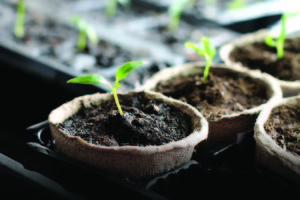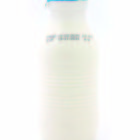Trending
micro-gardening
By Jaclyn Dawn
April, 2017
 Do you like the idea of gardening but don’t have the time, space, money or maybe confidence? Perhaps you’re already a gardener but the Alberta winter is simply too long for you. Welcome to micro-gardening, starting seeds indoors and creating terrariums. All three of these alternatives to traditional gardening can be tailored to individual abilities and lifestyle so that anyone can cultivate the benefits of gardening. Not convinced? Don’t worry. Even serial houseplant killers can manage these projects with a little guidance. Here’s how.
Do you like the idea of gardening but don’t have the time, space, money or maybe confidence? Perhaps you’re already a gardener but the Alberta winter is simply too long for you. Welcome to micro-gardening, starting seeds indoors and creating terrariums. All three of these alternatives to traditional gardening can be tailored to individual abilities and lifestyle so that anyone can cultivate the benefits of gardening. Not convinced? Don’t worry. Even serial houseplant killers can manage these projects with a little guidance. Here’s how.
Micro-gardening
Micro-gardening is growing vegetables, herbs and flowers in small spaces, indoors or outdoors. You don’t need a backyard garden or even a backyard—just a few containers big enough for whatever you are trying to grow. Micro-gardens can be as productive as traditional gardens, but require less space, labour and supplies, making them ideal for urban spaces and busy schedules.
Start by choosing what you want to grow. But be sure not to let the thousands of seed varieties and seedlings intimidate you. Simply reach for something you like, and read the package or plant tag to determine if it’s the right fit for you and where you want to grow it. If the package for hot peppers overwhelms you with talk of heat lamps, consider a simpler option such as spicy radishes. A current trend is growing vegetables to the seedling stage and harvesting them as microgreens. Some are ready in as few as 14 days! Imagine being able to add fresh cilantro to your omelette or pea shoots to the salad that came from the *cough* store. These tiny greens add big flavour and can easily be grown on your windowsill.
Once you’ve chosen what to plant, choose suitably sized containers. Flowers and vegetables vary in size above and below ground, so allow room for root development. You can use planters, boxes, baskets, clay pots, half barrels, used tires or even an old boot if the plant fits. Be creative by repurposing things around home to reduce costs and to express your unique style. Try growing peas on trellises on your balcony. Who wouldn’t like a hanging basket of strawberries? Grow lettuce and herbs in Grandma’s old wash basin. If you have heavy components in your micro-garden, use castors or containers with wheels to make relocating plants easier.
Lastly and most importantly, follow the directions on the packages or plant tags. The well-written ones tell you everything you need to know about sowing and caring for your plants.
Microgreens to consider: corn, broccoli, onions, chives, arugula and beet cress.
Starting Seeds Indoors
By starting seeds indoors, you extend the season to harvest plants with longer growing seasons and to harvest multiple crops of plants with shorter growing seasons. Seedlings can be transplanted outdoors after the last frost, which is mid-May in the Edmonton area.
Just as with micro-gardening, start by choosing what you like and read the packages. The packages will tell you when the seeds need to be planted in order to be ready for transplanting. If you are starting a variety of seeds, experts suggest keeping a seed-starting calendar. Some seeds should be started as early as February, while others should be planted four to six weeks before the last frost.
Once you’ve chosen your seeds, choose containers. Greenhouses, garden centres and even the Dollar Store carry fibre grow pots, which are biodegradable. When transplanting outdoors, plant the pot and all! You can also use ice cream cones, egg cartons or containers saved from the previous year. Keep in mind the size of the seedlings-to-be to avoid unnecessary transplants.
If you still aren’t sure of yourself or want to simplify starting seeds, you can purchase transplanting kits and self-watering systems that come with everything you need, including step-by-step instructions.
Lastly and most importantly, follow the directions on the packages for sowing and caring for your seeds.
Seeds to consider: nasturtiums, snapdragons, scarlet runners, marigolds, beans, lettuce and parsley.
Creating Terrariums
Did you reach for the dictionary? You’re not the only one. A terrarium is a miniature plant world grown in either an open or closed transparent
container. It’s like a garden made for the Borrowers or Smurfs. Terrariums, like all houseplants, can improve indoor air quality by absorbing pollutants from the air. They are also a unique way to add to your décor with less maintenance than regular houseplants.
When creating a terrarium, start by choosing your transparent container. Use a glass bowl, aquarium, vase, bottle, Mason jar—anything that allows light to pass through it.
Next, choose small, slow-growing plants that fit without touching the sides of the container and that won’t mind a humid environment, especially if creating a closed terrarium. Mix sizes, leaf textures, and colours; and make sure the plants like low to medium light. You’ll also want to be sure not to put your terrarium in direct sunlight; otherwise, the glass will cook your plants. When choosing your plants, select ones that like the same type of environment. Plants that go together, grow together.
Start your terrarium with a two-inch layer of stones to help control the moisture level and then an optional quarter- to half-inch layer of charcoal to prevent smell. Then add potting soil, plants and whatever trinkets suit your theme. You can add shells, a fish tank castle, coins and a pirate chest, a Batman figurine… have fun with it!
Lastly and most importantly—you guessed it—follow the directions on the plant tags. In this case, you want to lean on the side of neglect, avoiding overwatering and fertilizing because you want your plants to remain small. Prune yellowed and overgrown foliage, and air out closed terrariums monthly to prevent smells.
Plants to consider: African violets, orchids, succulents, moss, cacti, small ferns and spider plants.
Being responsible for another living thing can be an incredible and rewarding experience. And, if you make a mistake, gardens tend to be more forgiving than the cat. t8n
Growing Concerns
Factors in your gardening success:
Soil—Garden centres sell good-quality potting soil for
container gardens and custom blends appropriate for terrariums. Never use ‘dirt’ from the backyard.
It can introduce disease and may not provide the drainage your plants need.
Water—Most plants like soil that’s moist, not wet, so resist the urge to overwater. When you do water, avoid getting the foliage too wet to help prevent mould and blemishes.
Seed Quality—Seeds do expire and aren’t created equal, so inspect the packages and store your leftover seeds in a shoebox or other cool, dry, dark location.
Still Not Confident?
Many greenhouses, like Hole’s, offer intro classes, consultations and friendly conversation to browsers. Get tips and tricks, and ask as many questions as you like! There are also endless print and online resources.












